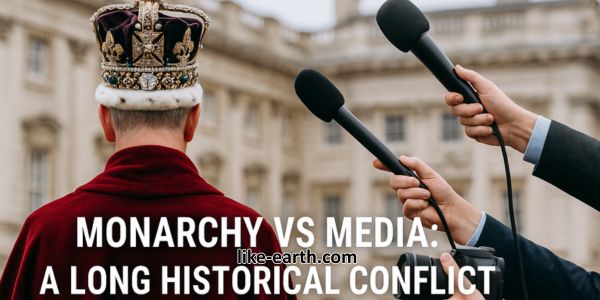Monarchy vs Media: A Long Historical Conflict

“Monarchy vs media: a long historical conflict” has been a defining narrative in global history, reflecting a turbulent interplay between power and information. From royal decrees to digital disruption, this relationship has transformed how societies understand authority, truth, and freedom of expression. This seven-word phrase encapsulates centuries of struggle between traditional rulers and evolving communication forces.
“`
The Origins of Monarchical Control
Long before newspapers and social media, monarchs relied on scribes and heralds to shape public opinion. These tools ensured the king’s message remained dominant and uncontested. In medieval Europe, information was power. Only the elite had access to it, and monarchs ensured that no dissenting voice could rise without consequences.
In England, the Licensing of the Press Act 1662 symbolized royal dominance. This law required government approval for all published materials. By controlling printing presses, monarchies effectively silenced critics and preserved their divine right narrative. Similar practices existed across France, Spain, and other kingdoms, where press freedom was virtually non-existent.
Revolutions and the Rise of the Free Press
The 18th and 19th centuries witnessed a dramatic shift. Enlightenment thinkers like Voltaire and Locke emphasized individual rights, including freedom of expression. The American and French Revolutions became turning points, challenging absolute power and empowering a burgeoning free press.
In France, the fall of the monarchy saw newspapers flourish. They became tools for change, informing citizens and fueling republican ideals. Monarchs, once unchallenged, now faced public scrutiny and even mockery. This era established journalism as a counterbalance to royal influence.
The Golden Age of Investigative Journalism
During the 19th and 20th centuries, journalism evolved into a powerful institution. The media exposed royal scandals, financial mismanagement, and colonial abuses. In Britain, Queen Victoria faced increasing press attention, with tabloids commenting on everything from her mourning attire to family controversies.
The rise of literacy and mass printing made newspapers accessible to the working class. Monarchs could no longer rely on secrecy. Even the British Royal Family, traditionally respected, came under fire, especially during events like the abdication crisis of Edward VIII and the tragic death of Princess Diana.
Modern Media and the Royal Image
Today, monarchies face a relentless 24/7 news cycle. Social media has amplified this, enabling real-time scrutiny. Royal families have adapted, creating official accounts to manage narratives and connect with younger generations.
However, conflicts persist. The British media’s coverage of Prince Harry and Meghan Markle exemplifies this tension. Accusations of racism, invasion of privacy, and biased reporting highlight ongoing power struggles. While monarchies have PR teams, the media’s independence ensures they cannot fully control the story.
Ethics, Censorship, and Accountability
The delicate balance between respecting tradition and defending press freedom remains a hot topic. Ethical journalism requires fairness, yet royal institutions often seek favorable coverage. In countries with active monarchies like Thailand or Saudi Arabia, criticism of royalty can lead to imprisonment, showing how media freedom is still threatened.
In democratic societies, laws protect free speech, but ethical dilemmas abound. Should media expose every royal detail? Is public interest always justified? These questions fuel debates among journalists and media watchdogs globally.
Royal Media Strategies in the Digital Age
To stay relevant, many royal families have embraced modern communication. The British royals use Instagram and YouTube to share curated glimpses of royal life. This transparency helps humanize their image and control the narrative.
Despite these efforts, public trust often leans toward independent journalism. Influencers, bloggers, and citizen journalists now compete with traditional media, reshaping how monarchies interact with the public. Information spreads faster than ever, leaving no room for outdated secrecy.
The Future: Coexistence or Continued Conflict?
As media evolves, so too must monarchies. The battle for narrative control is far from over. In an age where transparency and accountability are demanded, monarchies must adapt or risk irrelevance.
The phrase “Monarchy vs media: a long historical conflict” will continue to be relevant as long as power and free speech intersect. The story is not just about kings and reporters—it’s about who gets to tell the truth, and who decides what the truth is.
Conclusion: Lessons from History
From censorship to collaboration, the monarchy-media relationship has undergone seismic shifts. While kings once silenced dissent, today’s royals must navigate a minefield of headlines and hashtags. This evolution offers a crucial lesson: in a connected world, power lies not just in ruling, but in storytelling.
For more compelling articles on global issues, visit our official website.
Stay updated on media trends and monarchy news through our official WhatsApp channel. Monarchy vs Media



